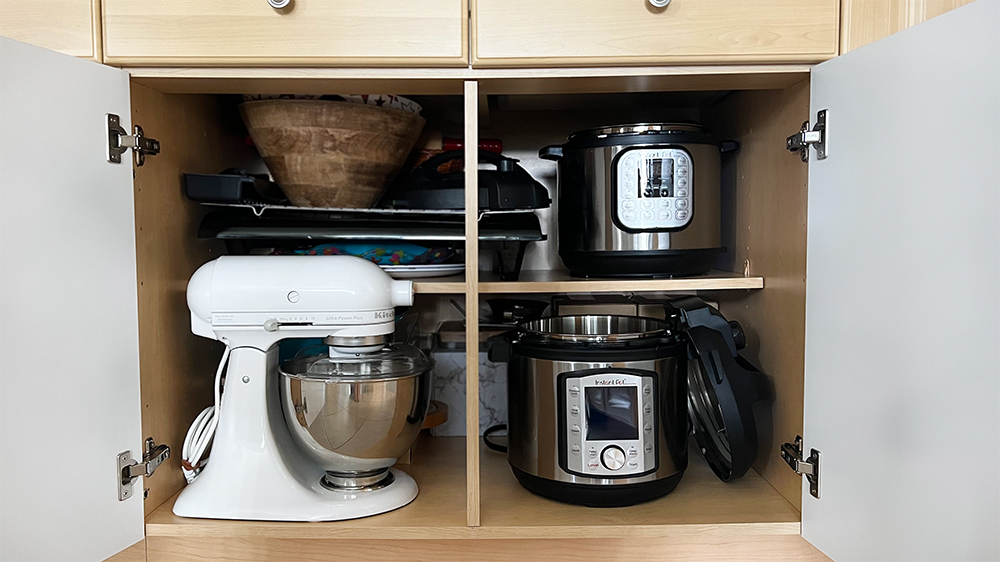Introduction: Making the Most of Your Kitchen Space
The kitchen is often the heart of the home, but it can also become cluttered and cramped, especially with the abundance of appliances available today. Maximizing space in your kitchen is essential for both functionality and aesthetics. By employing smart storage solutions, you can organize your kitchen appliances efficiently while also creating a visually appealing space.
1. Assessing Your Kitchen Layout: Optimizing Space Efficiency
Before diving into storage solutions, it’s crucial to assess your kitchen layout. Take note of areas that are underutilized or poorly organized. Consider the flow of your kitchen and identify opportunities to maximize space efficiency. This evaluation will serve as a foundation for implementing effective storage solutions tailored to your specific needs.

2. Decluttering Your Kitchen: Streamlining Appliance Inventory
One of the first steps in maximizing space is decluttering your kitchen appliances. Take inventory of all your appliances and assess their frequency of use. Donate or discard items that are seldom used or redundant. Streamlining your appliance inventory will free up valuable space and make it easier to organize the essentials efficiently.
3. Utilizing Vertical Space: The Power of Wall-Mounted Storage
Vertical space is often underutilized in kitchens but offers immense potential for storage. Install shelves or racks on the walls to store lightweight appliances such as blenders, mixers, and spice racks. Magnetic strips can also be used to hold metal utensils and knives, freeing up drawer space for other items. By taking advantage of vertical space, you can keep your countertops clear and create a more open and organized kitchen environment.

4. Investing in Multi-Functional Furniture: Versatility and Space Optimization
Multi-functional furniture pieces are invaluable in small kitchens where space is limited. Consider investing in kitchen islands or carts with built-in shelves or drawers to store appliances and utensils. These versatile pieces not only provide additional storage but also serve as extra workspace for meal preparation. Look for furniture designs that can be easily moved or folded to adapt to your changing needs.
5. Customizing Cabinets and Drawers: Tailoring Storage Solutions
Customizing cabinets and drawers is an effective way to maximize space and keep your kitchen organized. Install pull-out shelves or drawers with dividers to accommodate appliances of various sizes. Utilize cabinet doors by adding racks or hooks to store lids, cutting boards, and other accessories. Customized storage solutions can significantly increase the functionality of your kitchen while optimizing available space.

6. Embracing Underutilized Spaces: Making the Most of Corners and Nooks
Corner spaces and nooks are often overlooked but can be transformed into valuable storage areas with the right approach. Install corner shelves or rotating trays to access deep cabinets more easily. Utilize vertical dividers to organize baking sheets, cutting boards, and trays in tall cabinets or narrow spaces. By embracing underutilized spaces, you can effectively expand your kitchen’s storage capacity without adding bulk.
7. Implementing Drawer Organizers: Orderly and Accessible Storage
Drawer organizers are essential for keeping small kitchen appliances and utensils neatly arranged and easily accessible. Invest in adjustable dividers or customizable organizers to maximize drawer space and accommodate various items. Sort utensils, measuring spoons, and other small gadgets into designated compartments to maintain order and streamline meal preparation. Drawer organizers are simple yet effective tools for optimizing kitchen storage and efficiency.

8. Concealing Appliances: Creating a Sleek and Streamlined Look
For a sleek and streamlined kitchen aesthetic, consider concealing appliances behind cabinet doors or panels. Built-in appliances such as refrigerators, dishwashers, and microwaves can be seamlessly integrated into cabinetry to maintain a cohesive look. Appliance garages or pull-up cabinets can also be used to hide countertop appliances when not in use. Concealing appliances not only maximizes space but also creates a clutter-free environment that enhances the visual appeal of your kitchen.
9. Utilizing Overhead Storage: Capitalizing on Ceiling Space
Overhead storage is often overlooked in kitchen design but can provide valuable additional space for storing appliances. Install hanging pot racks or shelving units above countertops or islands to keep pots, pans, and other bulky items within easy reach. Utilize sturdy hooks or S-hooks to hang items such as mugs, utensils, and colanders, freeing up cabinet and drawer space for other essentials. By capitalizing on ceiling space, you can maximize storage capacity while adding a decorative element to your kitchen.

10. Downsizing Appliances: Opting for Compact and Space-Saving Options
In smaller kitchens or those with limited storage space, downsizing appliances can be a practical solution. Consider investing in compact or multi-functional appliances that can perform multiple tasks without taking up excessive room. Choose smaller-scale versions of appliances such as refrigerators, dishwashers, and microwaves to optimize space without sacrificing functionality. Additionally, look for collapsible or stackable kitchen gadgets and tools that can be easily stored when not in use, further maximizing available space.
11. Creating Zones for Specific Tasks: Organizing Appliances by Functionality
Organizing your kitchen appliances into specific zones based on functionality can help streamline meal preparation and cooking processes. Designate separate areas for food preparation, cooking, baking, and beverage stations, grouping related appliances and tools together. Store frequently used appliances near their respective zones for easy access, minimizing unnecessary movement and clutter. Creating designated zones not only maximizes space but also promotes efficiency and organization in the kitchen.
12. Maximizing Pantry Space: Organizing Non-Essential Appliances
If you have a pantry or dedicated storage area in your kitchen, utilize this space to store non-essential appliances and equipment. Install adjustable shelving or wire racks to accommodate appliances such as slow cookers, food processors, and bread makers. Use clear storage bins or baskets to corral smaller items and prevent clutter. By organizing non-essential appliances in the pantry, you can free up valuable cabinet and countertop space for everyday essentials, enhancing overall kitchen functionality.
Conclusion: Transforming Your Kitchen with Smart Storage Solutions
Maximizing space in your kitchen is essential for creating a functional and visually appealing environment. By assessing your kitchen layout, decluttering your appliances, and implementing smart storage solutions, you can optimize space efficiency and streamline your cooking experience. From utilizing vertical space to customizing cabinets and drawers, there are numerous strategies for maximizing storage while maintaining a stylish and organized kitchen. With these tips and techniques, you can transform your kitchen into a space that is both efficient and inviting for cooking and entertaining.









